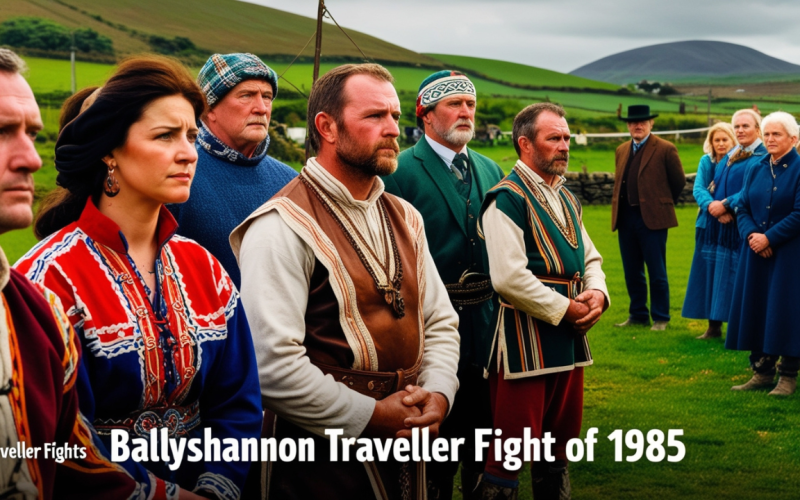Ballyshannon Traveller Fight 1985 is a notable event in Irish history, particularly within the Traveller community. Held in Ballyshannon, County Donegal, this gathering drew Travellers from across Ireland, underscoring the significance of family honor, tradition, and community ties. This article provides an in-depth look at Traveller customs, the 1980s social dynamics in Ballyshannon, and the lasting legacy of this event.
Key Takeaways
- The Ballyshannon fight of 1985 is a culturally significant event for the Irish Traveller community.
- The event emphasizes the Traveller community’s focus on family honor and conflict resolution traditions.
- The gathering reinforced community ties and showcased Traveller customs.
- The fight had a lasting impact on public perception of the Traveller community.
- Ballyshannon’s local history includes this event as a part of its cultural heritage.
Understanding Traveller Culture
Who Are the Irish Travellers?
Irish Travellers are a distinct ethnic group within Ireland, known for their unique culture, traditions, and strong family bonds. Historically, Travellers have maintained a nomadic lifestyle, prioritizing family loyalty and community unity. They have their own dialect, Cant, which further distinguishes their identity.
Importance of Honor and Family
Honor and family loyalty are central values within Traveller culture. Family disputes are treated with utmost seriousness, often requiring public resolution to uphold each family’s honor. This focus on honor was a significant reason for the Ballyshannon fight, which served as a way for families to settle disputes in a respectful, controlled environment.
Organized Fighting in Traveller Culture
Organized fights hold cultural significance within the Traveller community, serving as a structured and respectful means of conflict resolution. These fights are not merely physical contests; they are events conducted with specific rules and mutual respect. This approach emphasizes courage, family loyalty, and a commitment to preserving tradition, which are all valued deeply in Traveller society.
Ballyshannon in the 1980s
Historical Context of Ballyshannon
Ballyshannon, located in County Donegal, Ireland, is one of the country’s oldest towns. By the 1980s, Ballyshannon was a traditional community with a population of around 5,000, relying heavily on agriculture and local trade. The town’s strong Irish heritage made it a gathering point for Travellers, where they could celebrate customs and resolve disputes in accordance with tradition.
Social Dynamics and Traveller-Resident Relations
During the 1980s, Ballyshannon residents were familiar with the Traveller community, although interactions were sometimes marked by misunderstandings. The Travellers’ nomadic lifestyle and unique customs could create tension with local residents, particularly during large gatherings like the Ballyshannon fight. Despite these differences, such events offered a glimpse into Traveller traditions, fostering a mix of curiosity and caution among the settled population.
Events Leading Up to the Ballyshannon Fight
Origins of the Conflict
The Ballyshannon Traveller Fight of 1985 was the culmination of a long-standing dispute between two Traveller families. In Traveller culture, family honor is paramount, and disputes of this nature require resolution in a manner that respects each family’s reputation. The conflict leading to this fight involved both personal grievances and family loyalties, making it essential for both parties to agree on a structured resolution.
Family Disputes and Community Involvement
In Traveller culture, disputes extend beyond individuals to involve entire families and, at times, the broader community. This approach reflects the community’s collective values and the importance of maintaining social harmony. For the Ballyshannon fight, both families prepared carefully, involving key family members and community representatives to ensure a fair and respectful outcome.
Gathering of the Traveller Community
Travellers from across Ireland gathered in Ballyshannon for this event, highlighting the fight’s significance within the community. This was more than just a dispute resolution; it was an opportunity for social connection and cultural celebration. The gathering allowed Travellers to renew bonds, celebrate shared heritage, and witness the outcome of an important family conflict.
The Day of the Ballyshannon Fight
Location and Atmosphere of the Fight
The fight took place in a secluded area near Ballyshannon, where Travellers and local residents gathered to witness the event. The atmosphere was charged with anticipation, as onlookers awaited the resolution of a longstanding family dispute. The event’s respectful and structured nature was evident, with everyone understanding the cultural importance of the occasion.
Fight Protocol and Structure
The Ballyshannon fight adhered to a strict format with designated roles, demonstrating the structured nature of organized fighting within the Traveller community. This wasn’t an uncontrolled altercation but a carefully arranged event. A respected member of the community acted as a “referee,” ensuring that both participants adhered to the agreed-upon rules.
Roles of Key Participants
Central to the fight were the main fighters representing each family. These individuals, chosen for their courage and strength, bore the responsibility of defending their family’s honor. Family members and supporters watched closely, ensuring that the fight was conducted fairly and according to Traveller customs.
Aftermath and Impact on the Community
Immediate Reactions from the Community
Following the fight, responses from both the Traveller and Ballyshannon communities varied. Many Travellers viewed the resolution as necessary, emphasizing the fight as a demonstration of respect for tradition and family honor. However, others saw it as reinforcing certain stereotypes about Traveller culture, particularly in the eyes of the non-Traveller public.
Mixed Opinions and Family Dynamics
Among the families, opinions differed regarding the fight’s outcome and long-term impact. Some felt that the fight restored necessary balance and honor, while others experienced lingering tensions. The range of responses highlighted the complexity of family and community dynamics in Traveller culture, where collective reputation is often as important as individual resolution.
Impact on Traveller Society and Broader Community Perception
The Ballyshannon fight had a lasting influence on public perception of Travellers, drawing attention to their unique customs and ways of conflict resolution. Media coverage of the event varied, with some highlighting the cultural significance while others portrayed it negatively. For the Traveller community, the event became symbolic, reinforcing both cultural pride and the need for broader understanding.
The Legacy of the Ballyshannon Fight
Cultural Significance and Lasting Influence
Today, the Ballyshannon fight is remembered as a defining moment within Traveller history. It represents the commitment to family honor, tradition, and the structured resolution of disputes that remain core to Traveller identity. This event is a reminder of the values that shape Traveller culture and their impact on Irish society.
Lessons Learned and Evolving Traditions
While the Ballyshannon fight reflected longstanding customs, it also contributed to evolving perspectives within the Traveller community. Over time, some elements of traditional conflict resolution have shifted, balancing respect for tradition with changing societal norms. The legacy of this fight, however, remains a proud aspect of Traveller history.
Reflections on the Ballyshannon Traveller Fight
The event has inspired reflections from historians, community members, and family representatives who emphasize its cultural depth. Oral history plays a significant role in preserving this story, ensuring it remains an essential part of Irish and Traveller heritage.
FAQs about the Ballyshannon Traveller Fight of 1985
Q1. What was the Ballyshannon Traveller Fight of 1985?
The Ballyshannon Traveller Fight of 1985 was a structured fight between two Traveller families held to resolve a longstanding family dispute. It took place in Ballyshannon, Ireland, and attracted Travellers from across the country. The event emphasized the cultural importance of family honor and traditional conflict resolution within the Traveller community.
Q2. Why are organized fights significant in Traveller culture?
Organized fights hold cultural significance within Traveller society as a means of resolving disputes respectfully and upholding family honor. These fights follow a structured format with specific rules, allowing families to settle conflicts in a way that maintains dignity and respects both parties.
Q3. How did the Ballyshannon fight impact public perception of Travellers?
The Ballyshannon fight drew public attention to Traveller customs, with mixed reactions. While some saw it as a demonstration of cultural tradition, others viewed it through a lens of misunderstanding, reinforcing stereotypes. However, the event ultimately highlighted the importance of cultural respect and understanding.
Q4. Who participated in the Ballyshannon Traveller Fight?
The fight involved two lead fighters from opposing Traveller families, chosen to represent their families’ honor. A respected community member acted as a referee to ensure fairness, and family members and other Travellers attended to support and witness the event.
Q5. What is the legacy of the Ballyshannon Traveller Fight today?
The fight remains a memorable part of Traveller history, symbolizing the community’s dedication to family, honor, and tradition. It serves as a cultural touchstone, reminding the Traveller community of their unique customs while inspiring respect for their heritage among the broader public.
My Opinion
The Ballyshannon Traveller Fight of 1985 represents more than a single event—it is a reflection of a community’s dedication to family, tradition, and resilience. For the Irish Travellers, this fight demonstrated the importance of structured conflict resolution and the preservation of cultural values. Today, as society gains greater understanding of Traveller customs, the legacy of this event continues to highlight the depth and uniqueness of Ireland’s diverse heritage.





